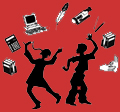Editing
our Podcasts
There are three types of podcasts:
- Regular - audio only
- Enhanced - audio with slides or pictures
- Video - video and slides
Our podcasts are enhanced podcasts. We divided the podcasts
into chapters so that people will be able to find certain clips
easily and added graphics to illustrate the chapters. We also
added pictures to enhance the information about the projects,
people and ideas being discussed. This part of the process was
not too difficult but finding, choosing and formatting the pictures
was very time consuming. We saved pictures in iPhoto
and used those pictures to illustrate our podcasts. We made
slides of the logo, the website address and some other illustrations
in Power Point, saved the slides as JPEG files and imported
them into iPhoto.
We used a music clip from an audio file in iTunes. We used the
intro to a piece called Sahara by Toumani Diabate and
Taj Mahal from the album Kulanjan released
in 1999 by Rykodisc
Records.
We cut out unwanted bits of the interviews, mostly places where
people had decided to repeat their comments and state their ideas
more clearly. We found it easier just to keep the tape rolling
and cut out the 'bloopers' later. This is very easy if the speakers
leave some space between the original attempt and the correction.
In the case of the Toronto recordings (Talking to Nadine & Susan and Talking
to Fran & Judi),
we were in the room and knew what to cut. In the case of the
Hazeltonrecording (Talking to Anne & Dee),
the participants noted what they wanted cut right in the recording
by pausing, saying, "Please cut that - we are starting again
here," and pausing again before continuing. This worked
very well.
The most difficult part of editing was trying to enhance the
audio quality. We are not sound technicians and played with settings
until it sounded as good as we could make it. The best thing
to do is to try and get a good quality recording as we did with
Talking to Nadine & Susan.
In the case of Talking to Fran & Judi,
we wanted to experiment with an ad hoc situation to see if we
could use podcasting as a way of involving more people in conference
conversations - we could record workshops or gather informally
post-workshop for discussions and broadcast the conversation.
We still feel that this would be a useful application for podcasts
in literacy. People could report on experiences and learning
without writing and people could hear about those experiences
by listening when they have time - while in the bath, exercising,
cooking ... We wonder if this might make information more accessible
to literacy workers who tell us that finding time to read and
write about their work is a challenge.
In the case of Talking to Anne & Dee,
we wanted to experiment with a low-tech situation to test the
accessibility limits of this technology. We found out that people
can create the audio file quite simply and, with the help
of an audio technician, the material can be converted
to a digital format. There is more post-production work to be
done but the Anne & Dee recording was actually of better quality
than Talking
to Fran & Judi.



